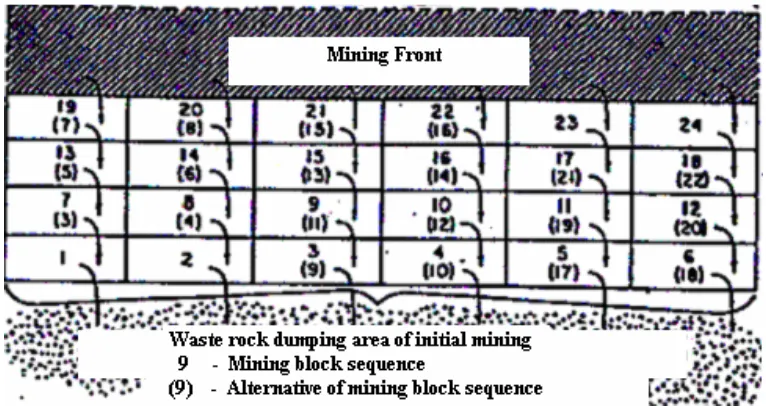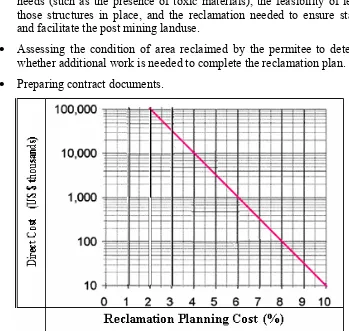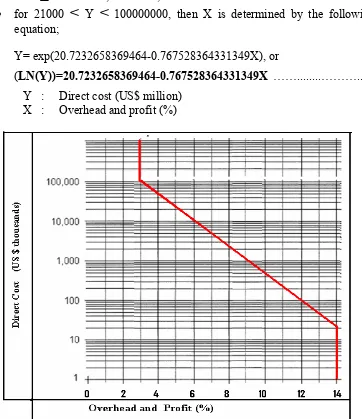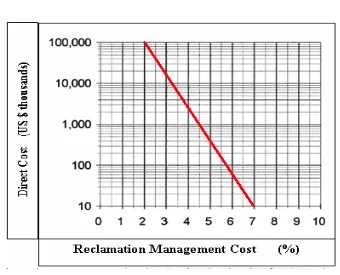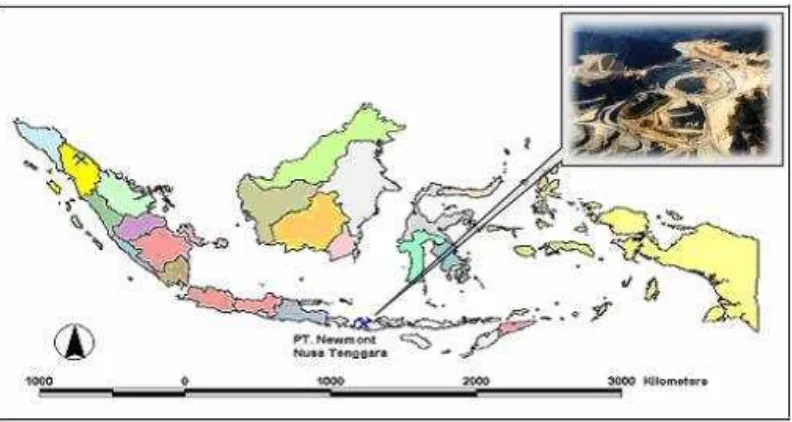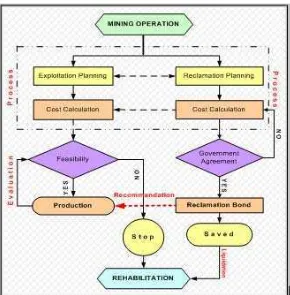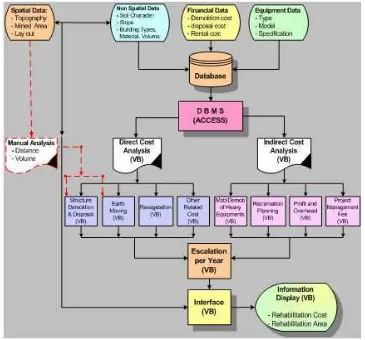Informasi Dokumen
- Penulis:
- Dede Ida Suhendra
- Pengajar:
- Hartrisari H.
- Hasrul L. Azahari
- Sekolah: Bogor Agricultural University
- Mata Pelajaran: Information Technology for Natural Resources Management
- Topik: Decision Support System for Rehabilitation Bond of Mining Area
- Tipe: Thesis
- Tahun: 2007
- Kota: Bogor
Ringkasan Dokumen
I. Introduction
This section provides the background of the research, focusing on mining management in Indonesia, including government regulations, company responsibilities, and various mining methods (surface and underground). It highlights the environmental impact of mining, particularly surface mining, and the importance of reclamation. The section also introduces the concept of mining reclamation bonds and the challenges in determining their appropriate amount, particularly with the decentralization of mining management under regional autonomy.
1.1. Background
This subsection details Indonesian mining legislation, emphasizing the national importance of mineral resources and the government's role in regulating the industry. It discusses different types of mining enterprises, their classifications, and the licensing process. The responsibilities of mining companies are elaborated, encompassing good mining practices, environmental management, safety measures, and financial obligations, including the crucial role of reclamation bonds.
1.1.1. Mining Management
This subsection delves into the decentralized nature of mining management in Indonesia since 1999, highlighting the roles and responsibilities of both central and local governments. The responsibilities of the central government include policy-making, guidance, supervision, and management of overlapping license areas. Local governments are responsible for resource management, company monitoring, and capacity building within their jurisdictions. The complexities introduced by regional autonomy are also acknowledged.
1.1.2. Mining Method
This subsection categorizes mining methods into surface and underground mining, detailing various sub-types within each category (e.g., open-pit, quarry, strip mining for surface; shaft, tunnel, drift mining for underground). It describes the stages involved in surface mining operations, highlighting the significant spatial impact and the need for careful planning. The discussion includes land management practices, including land clearing, topsoil removal, overburden removal, mineral excavation, and backfilling. Illustrations are used to clarify the concepts.
1.1.3. Land Management
This subsection focuses on the land management practices associated with surface mining, a critical area impacting the environment. It details the steps involved in surface mining, emphasizing the transformation of the landscape and the need for responsible post-mining land use. The role of backfilling and restoring the land is explained, along with alternative post-mining land uses such as water reservoirs, tourism sites, etc. The section concludes that inappropriate land management can lead to environmental deterioration.
1.1.4. Mining Reclamation Bond
This subsection introduces the concept of mining reclamation bonds, a crucial financial instrument guaranteeing post-mining land rehabilitation. It explains the legal basis for these bonds in Indonesian regulations and the process of determining their appropriate amount. The challenges in accurately assessing the required funds are discussed, emphasizing the need for both technical expertise and a comprehensive understanding of mining, environmental management, and cost estimation. The complexities of this assessment, particularly under regional autonomy, are highlighted.
1.2. Problem Identification
This subsection identifies the key challenges in determining reclamation bond amounts. The lack of a standardized, efficient process can lead to delays, financial losses for companies, and potentially flawed environmental outcomes. The need for skilled government officials is underscored due to the complex integration of mining principles, environmental planning, and cost estimation involved in the assessment. The issues are compounded by regional autonomy, leading to inconsistencies in the application of regulations and a need for capacity building among regional government officials.
1.3. Objectives
This subsection outlines the research objectives, which center on developing a decision support system (DSS) for mining reclamation bonds. The specific objectives include providing a tool for evaluating company cost estimations, determining adequate reclamation bond amounts (including direct and indirect costs), and raising awareness among stakeholders. The DSS aims to improve efficiency, consistency, and transparency in the bond determination process.
II. Literature Review
This section reviews existing literature on rehabilitation bonds, their legal frameworks, and the components of reclamation cost estimation. It explores the concept of decision support systems (DSS) and their application in environmental management. The direct and indirect cost components involved in reclamation bond calculations are detailed, along with relevant formulas and methods.
2.1. Reclamation Bond Provision
This subsection examines the legal aspects of reclamation bonds, referencing relevant Indonesian regulations and guidelines. It defines key terms like reclamation and its objectives, emphasizing the role of reclamation bonds as financial guarantees for post-mining land restoration. The division of reclamation costs into direct and indirect components is introduced, setting the stage for subsequent subsections detailing each component.
2.1.1. Direct Cost Component
This subsection focuses on the direct costs associated with reclamation, including mine facilities removal, material handling, re-vegetation, and other necessary activities. It discusses methods for estimating these costs, highlighting the challenges in standardizing the process due to the variability of mining operations and the nature of the civil works involved. Tables illustrate cost estimation examples from existing literature.
2.1.2. Indirect Cost Component
This subsection addresses the indirect costs involved in reclamation, encompassing mobilization and demobilization of equipment, reclamation planning, administration, contractor profits, and management costs. The interrelationship between direct and indirect costs is emphasized, suggesting that efficient planning can significantly influence overall costs. Illustrations demonstrate the cost relationships, highlighting the need for careful planning to minimize expenses.
2.1.3. Determining the Total Performance Bond Amount
This subsection briefly discusses the process of combining direct and indirect costs to determine the total reclamation bond amount. It highlights the importance of considering all relevant factors and the need for a systematic approach to ensure the bond is sufficient to cover all necessary reclamation activities. This lays the groundwork for the proposed DSS’s functionality.
2.2. Decision Support System
This subsection introduces the theoretical framework of decision support systems (DSS), emphasizing their potential in facilitating efficient and objective decision-making in complex situations. The four main software components of a DSS—data management, model management, knowledge management, and user interface—are described, establishing the foundational principles for designing and implementing the proposed DSS for reclamation bond calculation. This section provides the theoretical backing for the practical implementation in subsequent sections.
III. Methodology
This section details the research methodology, including time and location selection, materials and tools used (hardware and software), and the data collection process. It describes the overall research approach, encompassing legal aspects, DSS analysis (conceptual process, user needs analysis, and DSS construction). Flowcharts and diagrams are used to illustrate the methodology.
3.1. Time and Location Selection
This subsection justifies the choice of timeframe and location for the research. It mentions specific factors that influenced the selection, perhaps referencing a particular mining company or region as a case study. This provides context for the data used in the development and testing of the DSS.
3.2. Material and Tool
This subsection lists the hardware and software used in the research. This includes details of computers, programming languages (like Visual Basic), and any specialized software employed for data analysis and DSS development. It also specifies the types of data required for the DSS, such as cost data, material volumes, and other relevant parameters.
3.3. Method
This subsection describes the overall research methodology. It details the combination of techniques used, including conceptual design, legal analysis, and DSS development. It includes an explanation of user-needs analysis, demonstrating the iterative process of incorporating user feedback into the DSS design. The section highlights the importance of legal compliance in the context of Indonesian mining regulations.
IV. Result and Discussion
This section presents the results of the research, including the system analysis (database design and user interface design) and system implementation (DSS tool application and analysis). It details the database design process, from process modeling to the final physical model. The user interface design is discussed, and the functionality of the developed DSS application is described. Finally, it analyzes the performance and limitations of the developed system.
4.1. System Analysis
This subsection presents the analysis undertaken to design the DSS. It details the database design process, starting with process modeling (using techniques like data flow diagrams), then moving to a conceptual model (possibly using entity-relationship diagrams), a logical model (showing data structures), and finally, a physical model (specifying tables and data types). Tables and diagrams illustrating these models are included.
4.2. System Implementation
This subsection describes the implementation of the DSS, including the details of the application’s interface and functionality. It explains how the DSS incorporates the cost estimation models and allows users to input data. The section highlights the user-friendly design and features that support efficient reclamation bond calculation. Screenshots of the application interface are included to illustrate the design and ease of use.
V. Conclusion and Recommendation
This section summarizes the research findings, highlighting the contributions of the developed DSS. It concludes with recommendations for future development and implementation, such as further testing, refinement, and wider dissemination of the tool. It also discusses the system’s limitations and suggests areas for future improvement.
5.1. Conclusion
This subsection summarizes the main findings of the research, emphasizing the successful development and functionality of the DSS for calculating reclamation bonds. It reiterates the key benefits of the system, such as improved efficiency and accuracy in the calculation process, leading to more informed decision-making. The contribution of the research to the field of mining and environmental management is highlighted.
5.2. Recommendation
This subsection provides recommendations for future work, focusing on areas for improvement and wider application of the DSS. This might include suggestions for enhancing the system's accuracy, expanding its functionality, and conducting more extensive testing. The importance of disseminating the tool to relevant stakeholders—both government officials and mining companies—is emphasized.

